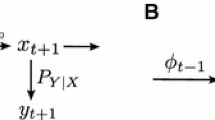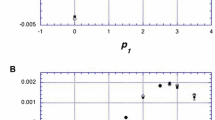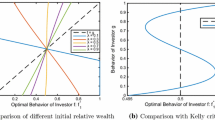Abstract
The notion of information pervades informal descriptions of biological systems, but formal treatments face the problem of defining a quantitative measure of information rooted in a concept of fitness, which is itself an elusive notion. Here, we present a model of population dynamics where this problem is amenable to a mathematical analysis. In the limit where any information about future environmental variations is common to the members of the population, our model is equivalent to known models of financial investment. In this case, the population can be interpreted as a portfolio of financial assets and previous analyses have shown that a key quantity of Shannon’s communication theory, the mutual information, sets a fundamental limit on the value of information. We show that this bound can be violated when accounting for features that are irrelevant in finance but inherent to biological systems, such as the stochasticity present at the individual level. This leads us to generalize the measures of uncertainty and information usually encountered in information theory.
Similar content being viewed by others
References
Maynard-Smith, J.: The concept of information in biology. Philos. Sci. 67(2), 177–194 (2000)
Jablonka, E.: Information: Its interpretation, its inheritance, and its sharing. Philos. Sci. 69(4), 578–605 (2002)
Szostak, J.W.: Functional information: molecular messages. Nature 423, 689 (2003)
Nurse, P.: Life, logic and information. Nature 454, 424–426 (2008)
Quastler, H. (ed.): Essays on the Use of Information Theory in Biology. University of Illinois, Urbana (1953)
Rashevsky, N.: Life, information theory, and topology. Bull. Math. Biol. 17, 229–235 (1955)
Atlan, H.: L’organisation biologique et la théorie de l’information. Hermann, Paris (1972)
Berger, T.: Living information theory. IEEE Inf. Theory Soc. Newsl. 53, 1–19 (2003)
Adami, C.: Information theory in molecular biology. Phys. Life Rev. 1, 3–22 (2004)
Taylor, S.F., Tishby, N., Bialek, W.: Information and fitness. arXiv:0712.4382 (2007)
Polani, D.: Information: currency of life? HFSP J. 5, 307–316 (2009)
Shannon, C.E.: A mathematical theory of communication. Bell Syst. Tech. J. 27, 379–423 (1948)
Shannon, C.E.: Coding theorems for a discrete source with a fidelity criterion. IRE Natl. Conv. Rec. 7, 142–163 (1959)
Cover, T.M., Thomas, J.A.: Elements of Information Theory. Wiley-Interscience, New York (1991)
Csiszár, I.: Axiomatic characterizations of information measures. Entropy 10, 261–273 (2008)
Shannon, C.: The bandwagon. Trans. Inf. Theory 2, 3 (1956)
Rosenblueth, A., Wiener, N., Bigelow, J.: Behavior, purpose and teleology. Philos. Sci. 10(1), 18–24 (1943)
Wiener, N.: Cybernetics: Or Control and Communication in the Animal and the Machine. MIT Press, Cambridge (1948)
Ashby, W.R.: An Introduction to Cybernetics. Chapman & Hall Ltd, London (1956)
Ashby, W.R.: Requisite variety and its implications for the control of complex systems. Cybernetica 1, 83–99 (1958)
Touchette, H., Lloyd, S.: Information-theoretic limits of control. Phys. Rev. Lett. 84(6), 1156–1159 (2000)
Touchette, H., Lloyd, S.: Information-theoretic approach to the study of control systems. Physica A 331, 140–172 (2004)
Mitter, S.K.: Control with limited information. Eur. J. Control 7(2–3), 122–131 (2001)
Marko, H.: The bidirectional communication theory—a generalization of information theory. IEEE Trans. Inf. Theory 21, 1345–1351 (1973)
Massey, J.L.: Causality, feedback and directed information. In: Proc. Intl. Symp. Info. Theory Applic. (ISITA-90), pp. 303–305 (1990)
Seger, J., Brockmann, H.J.: What is bet-hedging? Oxf. Surv. Evol. Biol. 4, 182–211 (1987)
Lewontin, R.C., Cohen, D.: On population growth in a randomly varying environment. Proc. Natl. Acad. Sci. USA 62, 1056–1060 (1969)
Real, L.A.: Fitness uncertainty and the role of diversification in evolution and behaviour. Am. Nat. 115, 623–638 (1980)
Stearns, S.C.: Daniel Bernoulli (1738): evolution and economics under risk. J. Biosci. 25, 221–228 (2000)
Wagner, A.: Risk management in biological evolution. J. Theor. Biol. 225, 45–57 (2003)
Stephens, D.W.: Variance and the value of information. Am. Nat. 134, 128–140 (1989)
Bergstrom, C.T., Lachmann, M.: Shannon information and biological fitness. In: Information Theory Workshop IEEE ’04, San Antonio, Texas, pp. 50–54 (2004)
Kussell, E., Leibler, S.: Phenotypic diversity, population growth, and information in fluctuating environments. Science 309, 2075–2078 (2005)
Donaldson-Matasci, M.C., Bergstrom, C.T., Lachmann, M.: The fitness value of information. Oikos 119, 219–230 (2010)
Kelly, J.: New interpretation of information rate. Bell Syst. Tech. J. 35, 917–926 (1956)
Breiman, L.: Optimal gambling systems for favorable games. In: Fourth Berkeley Symposium on Mathematical Statistics and Probability, pp. 65–78. University of California Press, Berkeley (1961)
Algoet, P.H., Cover, T.M.: Asymptotic optimality and asymptotic equipartition properties of log-optimum investment. Ann. Probab. 16, 876–898 (1988)
Barron, A.R., Cover, T.M.: A bound on the financial value of information. IEEE Trans. Inf. Theory 34, 1097–1100 (1988)
Cover, T.M.: Shannon and investment. IEEE Inf. Theory Soc. Newsl. (Special Golden Jubilee Issue) 10–11 (1998)
Permuter, H.H., Kim, Y.-H., Weissman, T.: On directed information and gambling. In: Proc. International Symposium on Information Theory (ISIT), Toronto, Canada (2008)
Perkins, T.J., Swain, P.S.: Strategies for cellular decision-making. Mol. Syst. Biol. 5, 326 (2009)
Karlin, S., Taylor, H.M.: A First Course in Stochastic Processes. Academic Press, New York (1975)
Pack Kaelbling, L., Littman, M.L., Cassandra, A.R.: Planning and acting in partially observable stochastic domains. Artif. Intell. 101, 99–134 (1998)
Furstenberg, H., Kesten, H.: Products of random matrices. Ann. Math. Stat. 31, 457–469 (1960)
Kingman, J.F.C.: Subadditive ergodic theory. Ann. Probab. 1, 883–899 (1973)
Tanny, D.: On multitype branching processes in a random environment. Adv. Appl. Probab. 13, 464–497 (1981)
Kramer, G.: Directed information for channels with feedback. PhD thesis, Swiss Federal Institute of Technology (ETH), Zurich (1998)
Kim, Y.-H.: A coding theorem for a class of stationary channels with feedback. IEEE Trans. Inf. Theory 25, 1488–1499 (2008)
Witsenhausen, H.S.: Separation of estimation and control for discrete time systems. Proc. IEEE 59, 1557–1566 (1971)
Berger, J.O.: Statistical Decision Theory and Bayesian Analysis. Springer, Berlin (1985)
Gastpar, M., Rimoldi, B., Vetterli, M.: To code, or not to code: lossy source-channel communication revisited. IEEE Trans. Inf. Theory 49, 1147–1158 (2003)
Leslie, P.: On the use of matrices in certain population mathematics. Biometrika 33, 183–212 (1945)
Kussell, E., Leibler, S., Grosberg, A.: Polymer-population mapping and localization in the space of phenotypes. Phys. Rev. Lett. 97, 068101 (2006)
Iyengar, G.N., Cover, T.M.: Growth optimal investment in horse race markets with costs. IEEE Trans. Inf. Theory 46, 2675–2683 (2000)
Tuljapurkar, S., Horvitz, C.C., Pascarella, J.B.: The many growth rates and elasticities of populations in random environments. Am. Nat. 162, 489–502 (2003)
Haccou, P., Iwasa, Y.: Optimal mixed strategies in stochastic environments. Theor. Popul. Biol. 47, 212–243 (1995)
Sasaki, A., Ellner, S.: The evolutionarily stable phenotype distribution in a random environment. Evolution 49, 337–350 (1995)
Merton, R.C.: Lifetime portfolio selection under uncertainty: the continuous-time case. Rev. Econ. Stat. 51, 247–257 (1969)
Godfrey-Smith, P.: Information in biology. In: Hull, D., Ruse, M. (eds.) The Cambridge Companion to the Philosophy of Biology, pp. 103–119. Cambridge University Press, Cambridge (2007)
Athreya, K.B., Ney, P.E.: Branching Processes. Springer, Berlin (1972)
Kurtz, T.G., Lyons, R., Pemantle, R., Peres, Y.: A conceptual proof of the Kesten-Stigum theorem for multi-type branching processes. In: Athreya, K.B., Jagers, P. (eds.) Classical and Modern Branching Processes. IMA Volumes in Mathematics and its Applications, vol. 84, pp. 181–185. Springer, New York (1997)
Bernoulli, D.: Specimen theoriae novae de mensura sortis. Pap. Imp. Acad. Sci. St. Petersburg 5, 175–192 (1738)
Markowitz, H.: Portfolio selection. J. Finance 7, 77–91 (1952)
Morsegaard Christensen, M.: On the history of the growth optimal portfolio. Unpublished (2005)
Samuelson, P.A.: The fallacy of maximizing the geometric mean in long sequences of investing or gambling. Proc. Natl. Acad. Sci. USA 68, 2493–2496 (1971)
Maynard Smith, J., Price, G.: The logic of animal conflict. Nature 248, 15–18 (1973)
Mills, S., Beatty, J.: The propensity interpretation of fitness. Philos. Sci. 46, 263–286 (1979)
Beatty, J., Finsen, S.: Rethinking the propensity interpretation: a peek inside Pandora’s box. In: Ruse, M. (ed.) What the Philosophy of Biology Is, Essays Dedicated to David Hull. Kluwer Academic, Dordrecht (1989)
Robson, A.J.: A biological basis for expected and non-expected utility. J. Econ. Theory 68, 397–424 (1996)
Hartley, R.V.L.: Transmission of information. Bell Syst. Tech. J., 535 (1928)
Author information
Authors and Affiliations
Corresponding author
Rights and permissions
About this article
Cite this article
Rivoire, O., Leibler, S. The Value of Information for Populations in Varying Environments. J Stat Phys 142, 1124–1166 (2011). https://doi.org/10.1007/s10955-011-0166-2
Received:
Accepted:
Published:
Issue Date:
DOI: https://doi.org/10.1007/s10955-011-0166-2




